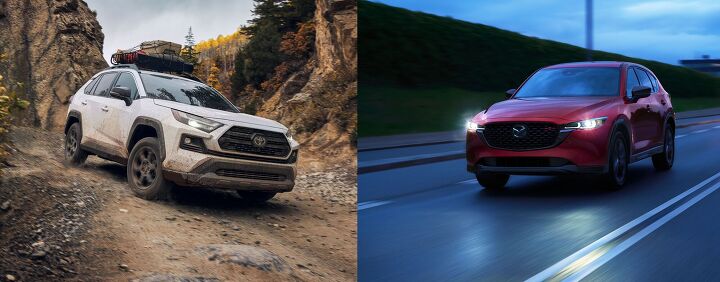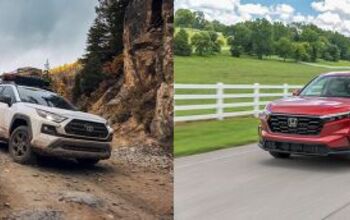Would You Rather? Toyota RAV4 vs Mazda CX-5

Last week’s match-up between the Honda CR-V and Toyota RAV4 was fairly close. However, readers seemed to gravitate toward the Toyota due to several factors. It boasted a traditional 8-speed automatic transmission, rather than a CVT, and made power from a larger motor that sidestepped forced induction. This led to many assuming the Toyota would handle long-term abuse better than the Honda — which was further supported by the vehicle having been on the market longer and proven itself as reliable.
As the point of this segment is to create the automotive equivalent of Sophie’s Choice, we’re bringing back the RAV4 and pitting it against the 2024 Mazda CX-5.
Both vehicles are nearing the end of their lifecycle and have remained incredibly popular choices. However, the Mazda takes some of those desirable on-road dynamics that made the CR-V appealing without adopting the smaller engine or CVT that enthusiasts tend to loathe.
As mentioned in our previous Would You Rather, the RAV4 comes with a 2.5-liter four-cylinder with 203 horsepower and 184 pound-feet of torque. While there are hybrid variants available, which pad the price and the vehicle's power output, it’s the only option for non-hybrid shoppers. Meanwhile, the CX-5 gives drivers the option of a base 2.5-liter pushing 187 horsepower (via an automatic 6-speed) or its upgraded variant that leverages a turbocharger to deliver 256 hp and an impressive 320 pound-feet of torque.
While the base Mazda does feel a tad more nimble and responsive on the pavement, it isn’t really any quicker. They’ll both hit 60 mph in about 8 seconds. But that immediately changes when drivers opt for the turbo variant of the CX-5, which Mazda says is capable of doing the same feat in just 6.6 seconds. That’s genuinely quick for a crossover in this segment.
Mazda’s powertrain also feels a little more refined than the Toyota, despite the latter being well served by its transmission having a couple extra gears. Since Mazda prizes itself on building cars that are engaging, the CX-5 is probably the most fun-to-drive crossover in the whole segment.
However, the real victory is that every version of the CX-5 comes with all-wheel drive as standard. The 2024 Toyota RAV4 starts at $28,475, whereas the 2024 Mazda CX-5 starts at $29,300. But the former requires an additional $1,400 to get AWD and you’ll likely be spending even more to get into some of the more desirable off-road trims.
This again, seems to make the Toyota the obvious choice for those seeking to hit some rough trails. However, you’ll also be spending quite a bit more to get into the more exciting version of the Mazda. The most affordable turbocharged models start right around $37,000.
Exterior appeal is more or less what we saw when we pitted the RAV4 against the Honda CR-V. Toyota’s entrant is a little more focused on ruggedness while its rival is targeting maximum beauty. Mazda’s design team has been doing exceptional work in recent years and its lineup is the proof.
While its newer crossovers have presented themselves as more butch, everything the company has right now will probably go down in history as more pleasing to the eye than the era’s status quo.
On the inside, it’s a clear victory for the Mazda. I’m not even willing to debate this. The company is producing interiors that feel like they come for much more expensive cars without all the hokey gimmicks. This also helps make the CX-5 more comfortable on long drives, as it boasts excellent seats and more standard features. The Mazda also comes with synthetic leather with the ability to upgrade to the real deal.
This is not an option on the Toyota, which comes with cloth seats and only lets you have synth leather as an upgrade.
Toyota’s Safety Sense is a fairly comprehensive package, as is Mazda’s i-Activsense Safety. While it’s extremely close between the two, the former probably has a few more features. But many drivers have already had their fill of electronic helpers and the difference is probably not great enough to be the deciding factor for most drivers. This one comes down to preference and what kind of driver assistance features you personally like to see on an automobile.
Though the RAV4’s utility is where it starts to reel the CX-5 back in. Toyota still has class-leading cargo capacity and more ways of storing things. With the seats folded, the Toyota offers 70 cubic feet of overall storage vs Mazda’s 59.3 cubic feet. But even with the rear row raised, you’ll still be getting a little more space in the Toyota.
The RAV4 is likewise more economical. But it’s again very close. EPA estimates have the base Toyota delivering 27 mpg in the city and 35 mpg on the highway. CX-5 models that lack a turbo should boast 26 mpg in the city and 31 mpg on the highway. Obviously those numbers rise when you opt for a RAV4 Hybrid and decline when you consider the turbocharged variant of the Mazda CX-5 (22/27 mpg city/highway).
Reliability is the last piece of the puzzle and here you would think it would be an easy victory for Toyota. But the Mazda CX-5 has actually received a higher predicted reliability score from J.D. Power and several other outlets. It’s extremely close in all cases, however, and the RAV4 does have slightly lower repair costs on average.
Furthermore, the fact that both of these vehicles have been around for a while has provided an opportunity to speak with owners and mechanics. You don’t hear a lot of complaints about either, which is good news no matter which model you pick.
I’ll be honest, when we put together our previous Would You Rather, I was probably leaning more toward the Toyota.
But this time around it really does feel impossible. The Mazda CX-5 really does appear to be the vehicle you’d want to be trapped inside during a long commute and has the hardware required to tackle bad road conditions. But the Toyota is very obviously the better workhorse by offering more cargo space, better optional off-road packages, and superior available towing.
The only real tragedy is that both vehicles are likely to be supplanted by newer models very soon. The Mazda CX-50 is already on the market and looks poised to take over in a manner similar to how the CX-30 usurped the excellent CX-3. Meanwhile, Toyota's RAV4 is expected to see a major redesign in 2025.
[Images: Toyota; Mazda]
Become a TTAC insider. Get the latest news, features, TTAC takes, and everything else that gets to the truth about cars first by subscribing to our newsletter.

Consumer advocate tracking industry trends and regulations. Before joining TTAC, Matt spent a decade working for marketing and research firms based in NYC. Clients included several of the world’s largest automakers, global tire brands, and aftermarket part suppliers. Dissatisfied, he pivoted to writing about cars. Since then, he has become an ardent supporter of the right-to-repair movement, been interviewed about the automotive sector by national broadcasts, participated in a few amateur rallying events, and driven more rental cars than anyone ever should. Handy with a wrench, Matt grew up surrounded by Detroit auto workers and learned to drive by twelve. A contrarian, Matt claims to prefer understeer and motorcycles.
More by Matt Posky
Latest Car Reviews
Read moreLatest Product Reviews
Read moreRecent Comments
- Lorenzo If it's over 30 years old and over 80k miles, and not a classic, it's a parts car, worth no more than 20% of original price.
- Dusterdude No mileage noted on a 33 year old car means likely well north of 300k + miles , along with issues noted , should equate to an ask price of less than $3k
- Ajla IMO, something like this really should be naturally-aspirated.
- Kjhkjlhkjhkljh kljhjkhjklhkjh Unless they are solid state batteries you BAN THEM. I like EVs... but EVs like to burn ... for days
- Kjhkjlhkjhkljh kljhjkhjklhkjh uh .. it looks like a VW golf got the mumps













































Comments
Join the conversation
Both the Toyota RAV4 and Mazda CX-5 are excellent choices, but it depends on what you value more. The RAV4 offers reliability and practicality, while the CX-5 shines with its sporty handling and upscale interior.
Best in class , both in a different way. If I lived in part of the county with poor roads and needed 10% extra cargo I would swing for RAV and if roads are ok and I need on road vehicle with great AWD i would take CX-5.